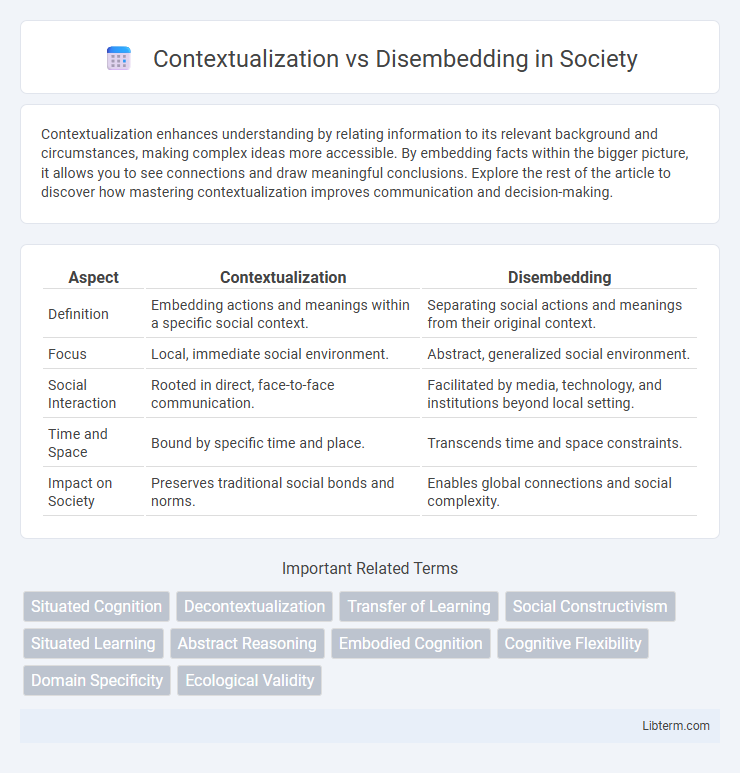Contextualization enhances understanding by relating information to its relevant background and circumstances, making complex ideas more accessible. By embedding facts within the bigger picture, it allows you to see connections and draw meaningful conclusions. Explore the rest of the article to discover how mastering contextualization improves communication and decision-making.
Table of Comparison
| Aspect | Contextualization | Disembedding |
|---|---|---|
| Definition | Embedding actions and meanings within a specific social context. | Separating social actions and meanings from their original context. |
| Focus | Local, immediate social environment. | Abstract, generalized social environment. |
| Social Interaction | Rooted in direct, face-to-face communication. | Facilitated by media, technology, and institutions beyond local setting. |
| Time and Space | Bound by specific time and place. | Transcends time and space constraints. |
| Impact on Society | Preserves traditional social bonds and norms. | Enables global connections and social complexity. |
Understanding Contextualization
Understanding contextualization involves recognizing the process through which elements acquire meaning within a specific setting, linking cultural, social, and historical factors to interpret information accurately. It emphasizes the interdependence between text and context, allowing for more nuanced analysis beyond isolated facts. Mastery of contextualization enhances comprehension by situating data within relevant frameworks, contrasting with disembedding, which abstracts elements from their original environment.
Defining Disembedding
Disembedding refers to the process of separating social relations and cultural practices from their local context, enabling activities to be shaped by abstract systems or remote contexts rather than immediate, face-to-face interactions. This concept highlights how economic, political, and social exchanges operate independently of specific locations, often facilitated by modern technologies and institutional frameworks. Unlike contextualization, which embeds interactions within local meanings and settings, disembedding enacts a shift towards generalized, decontextualized mechanisms governing social life.
Historical Evolution of Contextualization
The historical evolution of contextualization traces its origins to anthropological and linguistic studies in the early 20th century, emphasizing the importance of understanding social and cultural contexts to interpret meaning accurately. Early scholars like Bronislaw Malinowski pioneered the concept by highlighting how language and actions are embedded in specific situational contexts, contrasting sharply with the concept of disembedding that involves abstracting social relations from local contexts. Advances in sociology and communication studies further developed contextualization as a dynamic process, recognizing how meaning is shaped and reshaped through interaction within particular historical, cultural, and social frameworks.
The Rise of Disembedding in Modern Society
The rise of disembedding in modern society reflects a shift where social relationships and institutions are increasingly lifted out of localized contexts and restructured across time and space through abstract systems like digital networks and bureaucratic organizations. This process contrasts with contextualization, which emphasizes embedding interactions within specific social and cultural settings. Disembedding facilitates global connectivity and institutional complexity but often leads to challenges in maintaining social cohesion and cultural continuity.
Key Differences: Contextualization and Disembedding
Contextualization involves placing information within a relevant framework to enhance understanding, emphasizing the relationship between data and its environment. Disembedding isolates information from its original context, enabling analysis or use of that data independently from surrounding influences. The key difference lies in how contextualization integrates meaning through surrounding details, while disembedding abstracts and separates data to emphasize its standalone attributes.
Impact on Communication and Interpretation
Contextualization anchors communication in shared social and cultural references, enhancing clarity and mutual understanding by providing necessary background information. Disembedding removes elements from their original context, enabling abstract interpretation but often increasing ambiguity and misinterpretation risks in communication. The balance between contextualization and disembedding shapes message effectiveness, influencing how intended meanings are perceived and understood across diverse audiences.
Cultural Implications: Local vs Global Perspectives
Contextualization emphasizes understanding cultural practices and meanings within their local environments, fostering deeper connections and preserving cultural identity. Disembedding involves extracting elements from their original cultural contexts to apply them universally, which can lead to homogenization and loss of local significance. Balancing local cultural nuances with global integration challenges societies to maintain authenticity while engaging in cross-cultural exchanges.
Contextualization in Education and Learning
Contextualization in education involves integrating new information with learners' existing knowledge and real-world experiences to enhance understanding and retention. This approach promotes deeper cognitive connections and meaningful learning by situating content within relevant social, cultural, and practical frameworks. Emphasizing contextualization supports active engagement, critical thinking, and the application of knowledge in diverse, authentic situations.
Disembedding and Technological Change
Disembedding involves extracting social relations from localized contexts, allowing interactions to occur independently of physical or face-to-face settings. Technological change, such as digital communication platforms and global networks, accelerates disembedding by enabling social, economic, and cultural exchanges across vast spatial and temporal distances. This transformation reshapes traditional structures, facilitating new forms of social organization and interaction beyond immediate environments.
Choosing the Right Approach: Practical Applications
Contextualization involves embedding information within relevant situational or cultural frameworks to enhance understanding, ideal for fields like education, marketing, and social sciences where background shapes interpretation. Disembedding extracts data or concepts from their original context to analyze or apply them independently, useful in data science, law, and technology where universal principles or patterns are sought. Choosing the right approach depends on the goal: contextualization for nuanced, audience-specific insights, and disembedding for generalizable, abstract analysis.
Contextualization Infographic

 libterm.com
libterm.com